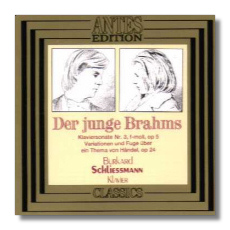
The Internet's Premier Classical Music Source
Related Links
- Brahms Reviews
- Latest Reviews
- More Reviews
-
By Composer
-
Collections
DVD & Blu-ray
Books
Concert Reviews
Articles/Interviews
Software
Audio
Search Amazon
Recommended Links
Site News
 CD Review
CD Review
Johannes Brahms

Early Piano Music
- Sonata #3 in F minor, Op. 5 (1853)
- Variations & Fugue on a Theme by Handel Op. 24 (1861)
Burkard Schließmann, piano
Antes Edition Classics BM-CD 31.9008 LC 7985 DDD 68:29
This is the inaugural disc in Schließmann's Brahms solo piano cycle. Antes will release two more recordings in short order: the Op. 10 Ballades, the Rhapsodies Op. 79, and the four late piano cycles, Op. 116 & 119. I have heard tapes of those performances, and I think Antes' faith in Schließmann is justified. I expect he is grateful for the opportunity – I can't imagine a record company of (Polygramesque) size lavishing this kind of attention on a young artist. Usually they tag someone young and beautiful who can knock out a few romantic concertos with solid technique, and then can take that show on the road. (Record covers with the likes of Nadja Salerno Sonnenberg inviting us to peer down her blouse tend to sell themselves, don't they?) Their success is often short-lived – just check the cut-out bins to find the latest casualty.
With the Sonata Op. 5, the twenty year old Brahms created a towering monument to Sturm und Drang, thereafter beginning his retreat into strict formalism. He never wrote another sonata for piano, that impetuous romance giving way to an almost dour melancholia. Schließmann's playing of this work competes less for your attention than for your interest. There's plenty of drive in the finale, and the Scherzo gallops along, but it's his playing of the slow movements that pulls you in. He makes the poco più lento a langorous barcarolle.
Schließmann's hyper-expressive technique courts trouble when he fosters too many interpretive ideas at once. The minutiae of rubato, dynamics, and touch border on the precious at times, as if he were afraid to make an ugly sound. And that is next to impossible on the Hamburg Steinway he plays, which enjoys a much warmer sound than its American counterparts (sample John O'Conor's recording
Copyright © 1998, Robert J. Sullivan

















